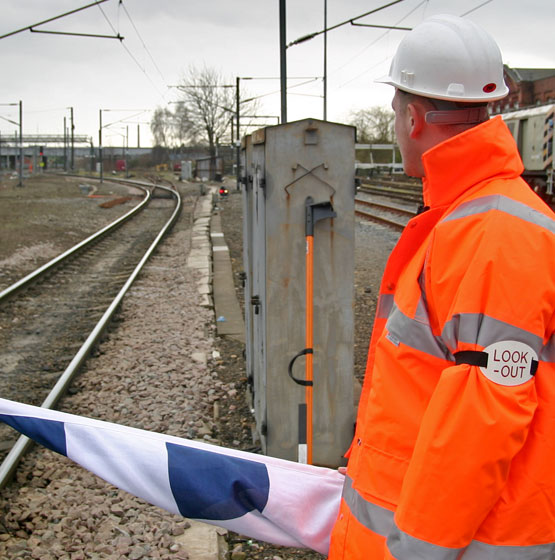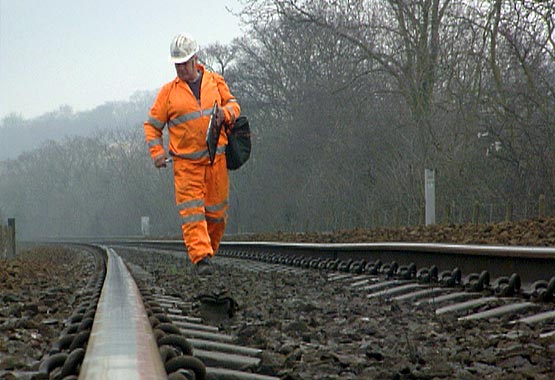|
You will have gathered by now that my safety allegiances are firmly rooted in ballast - amongst those with dirty hands and wry smiles - rather than the carpeted office suites where theoretical specialists do their embroidery. But I am occasionally prompted to tug on my remaining hairs by the eagerness of some trackworkers and their union representatives to discharge firearms at their feet either through folly or a blatant attempt to overegg the pudding.
On 13th August, a gang working on the single line between Swindon and Kemble had an uncomfortably near miss with FGW’s 0940 Cheltenham to Swindon service whilst working red zone in the 100mph section. As the driver approached she sounded a warning but the group - one of whom apparently had his head close to the rails - neither acknowledged nor moved clear, forcing her to make an emergency brake application. According to Network Rail’s report, it transpired that the site lookout had decided only to watch for trains coming from Swindon as the last one to pass them was heading in the opposite direction!
This potentially fatal error of judgement was made by someone who had presumably been passed as ‘competent’. He might well have worked previously on that same section of track, taking the same approach to his duties. The workgroup should thank their lucky stars for the vigilance of the driver and modern brakes.
As someone never short of an opinion, I find the deliciously blunt nature of RMT press releases a delight to behold and they invariably paint a smirk across my face. Of course, looking at the broader picture, that’s not necessarily an endorsement of them if the union wants its concerns to be taken seriously. Its habit of late has been to blow some issues up out of all proportion, creating the very real risk that a legitimate issue will be written off as scaremongering without duly being considered by the wider world. At a time of upheaval, it would be easy for the occasional safety nuance to slip beneath the radar; it’s vital that these are detected and tackled before they become critical. The union has an important role to play in this regard and needs to set about it responsibly.
My eyes were opened widely by its recent proclamation about Network Rail “ignoring normal safety practices by removing lookouts for patrolling in the Lancashire and Cumbria region”, a move described by Bob Crow as “unbelievably reckless”. How can NR get away with that, I mused - red zone working without any means of warning?
Of course, the release failed to mention that not all of the lookouts are going and, in any case, these patrols are not taking place on open lines as one might have inferred, rather in possessions on a Sunday morning. In theory, the lookouts have been there to protect the patrolmen from engineering train movements but the union seems more concerned about the prospect of another runaway, such as the one that had appalling consequences for four trackworkers at Tebay in 2004.
Since April 2006, the majority of West Coast Main Line patrols north of Preston have been carried out in T3s on Sunday mornings, starting at dawn and ending around 1030 - a period limited during mid-winter to just a couple of hours. This regime was driven by red zone restrictions imposed following the WCML upgrade that brought with it Enhanced Permissible Speed (EPS). It’s a weekly commitment that consumes significant levels of manpower - a resource that’s dwindling - as the patrols have to be divided into sections short enough to be completed within the available time. The possessions are generally taken at 2330, or thereabouts, on Saturday night to accommodate other routine maintenance activities.
So how should the patrols be protected? Let’s consider the rules first before delving into the nuts and bolts.
If the possession was taken only for the patrolling - in other words, it contained no engineering trains or OTP - T3.10.1 effectively defines the area between the PLBs as a worksite and, assuming both lines are blocked, a safeguarded green zone ensues. Clearly no lookouts are needed in such circumstances.
But the safe system becomes altogether more complicated if steel wheels are present and the patrols are taking place beyond the limits of any worksite. In this no-man’s land, the area on or within 2 metres of the track cannot be established as a green zone and therefore red zone working has to apply, with a method of warning provided. If the COSS ‘books in’ with the PICOP, he can rely on the speed of approaching trains being restricted to 40mph but they could come from either direction on any line within the possession. Without the PICOP’s permission, full linespeed must be assumed.
If the patrolman is certified as a COSS or IWA, the rules allow him to carry out this duty alone (T7.1.5). Such an arrangement is not permitted in darkness but that doesn’t appear to be an issue in this case. So Network Rail’s move seems ‘legal’ in general terms.
The warning time required for a lone patrol will probably be 25 seconds: the basic 10 seconds in the position of safety, 5 seconds to get there, 5 seconds because the patrolman is alone and another 5 seconds because he has to check for trains in both directions, this being a possession with normal signalling suspended. Based on this, the required sighting distance at 40mph is 500 yards. Is that always available on the tight curves through this area? I don’t know for certain - I’m not really familiar with it - but I would suspect not. That’s potential failing number one.
And what about the practicality of this arrangement and the quality of the resulting patrol? This lone wanderer not only has to check the track and its furniture with due care and attention, he also has to look up every five seconds or so - both forwards and back - to check if a train is coming. Something will surely suffer and, given the commitment of most Sentinel card holders to their work duties, it will probably be his compliance with the mandates in T7. Remember, A D Little’s 2004 research into the root causes of red zone working found that lone workers were amongst the most vulnerable when it comes to being struck by trains.
But “unbelievably reckless” is emotive language and completely out of proportion with the risks. Suggesting that lookouts are needed in order to mitigate runaways will be seen by any right-minded observer as nonsense. If we’re in that business, we ought to be providing Chieftain Tanks in case of a road vehicle incursion. Tebay emerged from a tragic fusion of criminality, incompetence, darkness and worksite noise. None of those factors raise their heads on these patrols.
|
| If we’re in that business, we ought to be providing Chieftain Tanks in case of a road vehicle incursion. |
|
By taking this approach, is Network Rail really “playing fast and loose with safety” as Bob Crow asserts? There is certainly a case to be made that the protection of these patrolmen will be compromised by their inability to do all that is theoretically required of them with due diligence. Quite how much risk that would expose them to in practice I will leave for others to judge. And if they did meticulously comply with the Rule Book in relation to working alone, the quality of the patrol might well be questionable.
So perhaps the union has an underlying case. But it would be much stronger if its argument was made more lucidly - presenting sensible evidence - rather than employing its megaphone to spout hyperbole. The RMT too needs to root itself in ballast.
Story added 1st September 2010
|